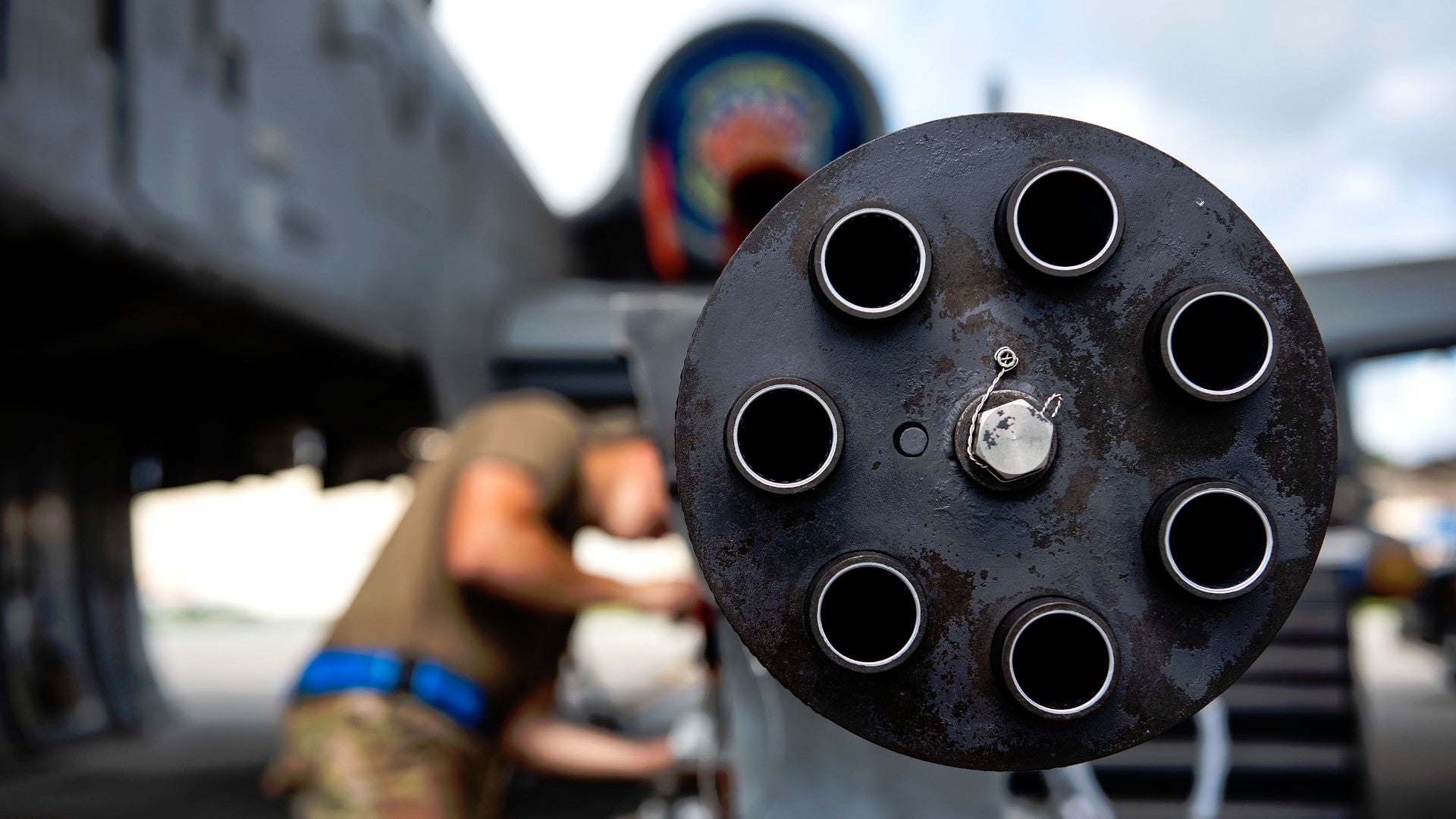The U.S. military is looking into what it would take to dismantle and dispose of more than 35,000,000 rounds of ammunition with depleted uranium cores, predominantly 30mm shells for the iconic GAU-8/A Avenger cannon on the A-10 Warthog ground-attack aircraft. This comes more than a year after the U.S. Air Force revealed it was looking into the possibility of stopping using these controversial rounds for good.
The U.S. Army is managing the potential “demilitarization and disposal” of the depleted uranium (DU) ammunition, which also includes hundreds of thousands of 105mm and 120mm armor-piercing tank shells. The Army’s Product Manager for Demilitarization and the U.S. Army Joint Munitions Command had first put out a notice of the potential contract on Sept. 17, 2019. The announcement stressed that there has been no final decision about whether or not to go ahead with getting rid of the ammunition.
The Army has provided prospective contractors with a detailed list of the types of ammunition and the total number of rounds of each type that they could be called upon to break down. The final tally is 35,748,417 individual rounds of all types in storage at eight different Army facilities, the Anniston Munitions Center (ANMC), Blue Grass Army Depot (BGAD), Crane Army Ammunition Activity (CAAA), Iowa Army Ammunition Plant (IAAAP), Letterkenny Munitions Center (LEMC), Hawthorne Army Depot (HWAD), McAlester Army Ammunition Plant (MCAAP), and Tooele Army Depot (TEAD).
You can browse the full list below:

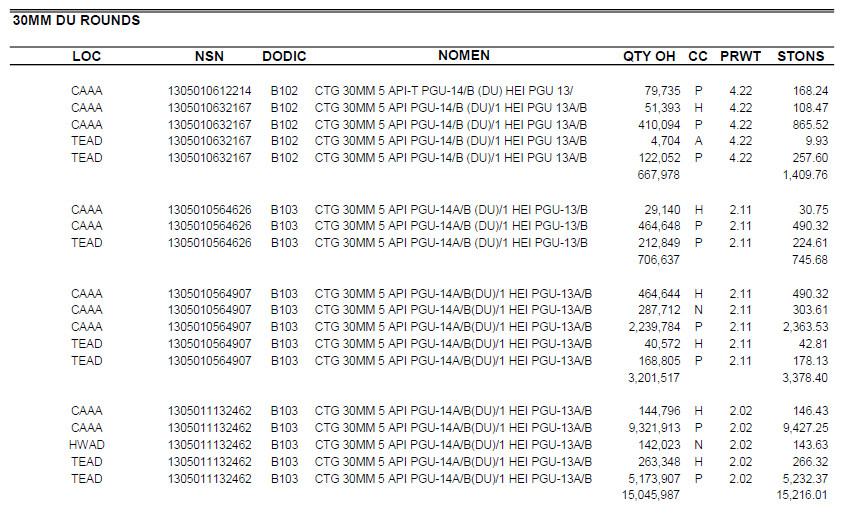
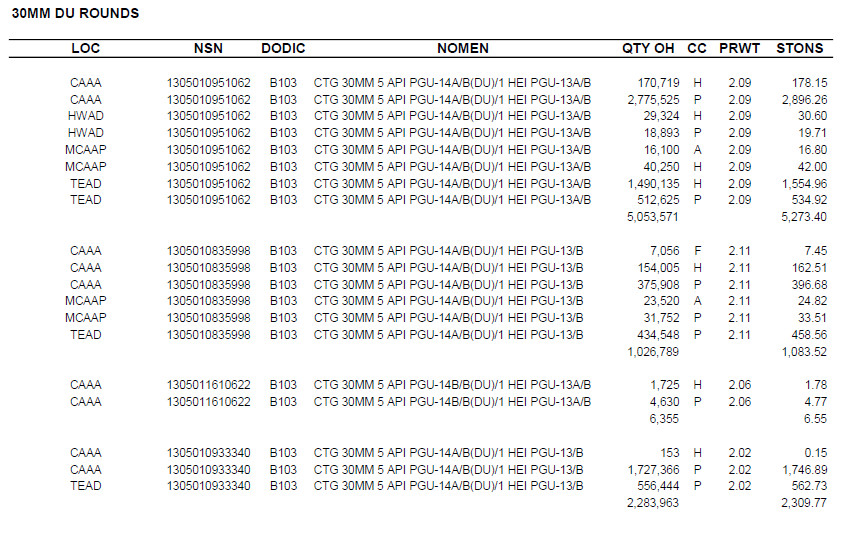
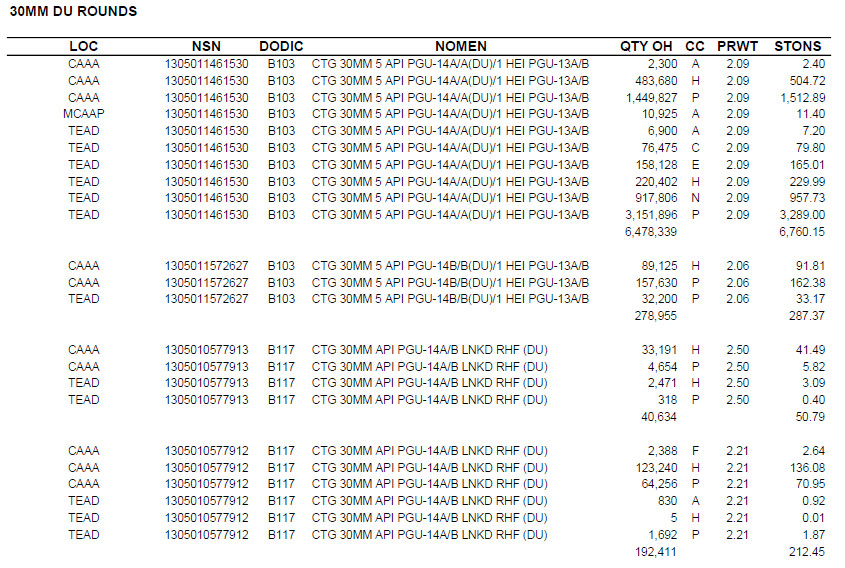

Of these, just 277,718 are a mix of 105mm M833, M900, 120mm M829A1 rounds, and A2 tank shells. The final disposal of the M833 and M900 rounds makes good sense. The U.S. Army and Marine Corps no longer operate any tanks with versions of the 105mm M68 main gun that can fire these rounds, such as early variants of the M1 Abrams or the older M60A3 and M48A5 Patton tanks. The M900 was only ever certified for use in the longer M68A1E2 gun found on earlier M1 and IPM1 tanks, to begin with. These rounds will not work in the M1128 Stryker Mobile Gun System’s M68A1E5 gun and its autoloader. The Army and Marines have also already supplanted the M829A1 and A2s with improved A3 and A4 versions for use with their later model M1 tanks.
The remaining 35,470,699 are 30x173mm shells intended for the GAU-8/A. These include armor-piercing PGU-14/B, -14A/B, and -14B/B rounds with DU penetrators, as well as belts of ammunition interspersed with PGU-13/B and -A/B high-explosive incendiary shells that have no DU. One would imagine that the Army would seek to recover the HEI rounds for later use as the contracting notice says nothing about disposing of non-DU ammunition and the PGU-13/B family remains in U.S. military use across multiple platforms, including Air Force AC-130W and J model gunships. It’s unclear whether this represents the entire stockpile of PGU-14/B rounds left anywhere within the U.S. military.

The contracting announcement offers this description of the PGU-14A/B’s design, which is broadly applicable to the other variants, to help potential vendors develop a plan to dismantle and dispose of the rounds:
The PGU-14A/B Armor Piercing Incendiary (API) – Kinetic energy [KE] projectile is used against armored targets. The PGU-14A/B API Armor Piercing Incendiary round has a lightweight body, which contains a sub-caliber high-density penetrator of DU. In addition to its penetrating capability; DU is a natural pyrophoric material, which enhances the incendiary effects. This round is effective against tanks and personnel carriers. The projectile is made up of four parts: an aluminum body or pusher, glass-reinforced nylon rotating band, DU rod penetrator, and aluminum windshield. The projectile has no fuze; its penetration depends on the shape of the penetrator, KE of the round, and grazing angle at impact.

The DU penetrators inside the PGU-14/Bs can punch through inches of rolled homogenous steel armor at ranges greater than 1,000 yards. A-10 pilots would also try, whenever possible, to attack tanks and other armored vehicles in their more vulnerable top and rear flanks, making the rounds particularly effective. Since the rounds fly at such high speeds and contain no explosive, relying simply on the sheer force of their impact to bust through armor, explosive reactor armor and active protection systems are unlikely to defeat them, as well.
Unfortunately, the oldest stockpiled rounds, which have been in service since the 1970s when the A-10’s primary mission was to have been busting up hordes of Soviet and Wasaw Pact tanks in Europe, have been becoming increasingly unsafe to use. As of May 2018, the average age of PGU-14/B rounds was 32 years old, according to Military.com. At that time, the Air Force had growing concerns about whether the primers and propellants in the cartridges would perform as expected and ensure the actual projectiles went safely flying out of the GAU-8/A’s barrels.
The A-10 is the only aircraft to carry the Avenger, which is a seven-barrel, electrically-driven Gatling cannon that can fire 70 rounds every second from what is known as a double-ended ammunition feed. What this means is that empty cartridge cases get cycled back into the massive drum magazine that feeds the gun after firing. This design eliminates the need to physically eject the cases out of the Warthog, where there would be a risk of them becoming hazardous aerial debris and potentially damaging the plane.

The entire system, however, is a finely tuned machine. If the projectiles don’t exit the barrel when they’re supposed to, it can quickly lead to a serious malfunction.
“I have 4.5 milliseconds from the time I initiate that round to get the projectile out the muzzle,” Bob DuPont, a member of the 780th Test Squadron at Eglin Air Force Base in Florida, had told Military.com in May 2018. “Anything beyond six milliseconds is catastrophic for this system.”
It now appears that the Air Force, via the Army, has decided to move ahead with simply disposing of these older rounds altogether. This also raises the question of whether the service will stop using DU ammunition in the A-10 entirely.
“There’s a lot of discussion of whether we’re going to use depleted uranium again, or the tungsten penetrator,” DuPont had noted back in 2018. “We’re going to try to keep the weight the same, but it will have a less penetration capability because of the density of the material, DU being more dense [sic] than tungsten.”
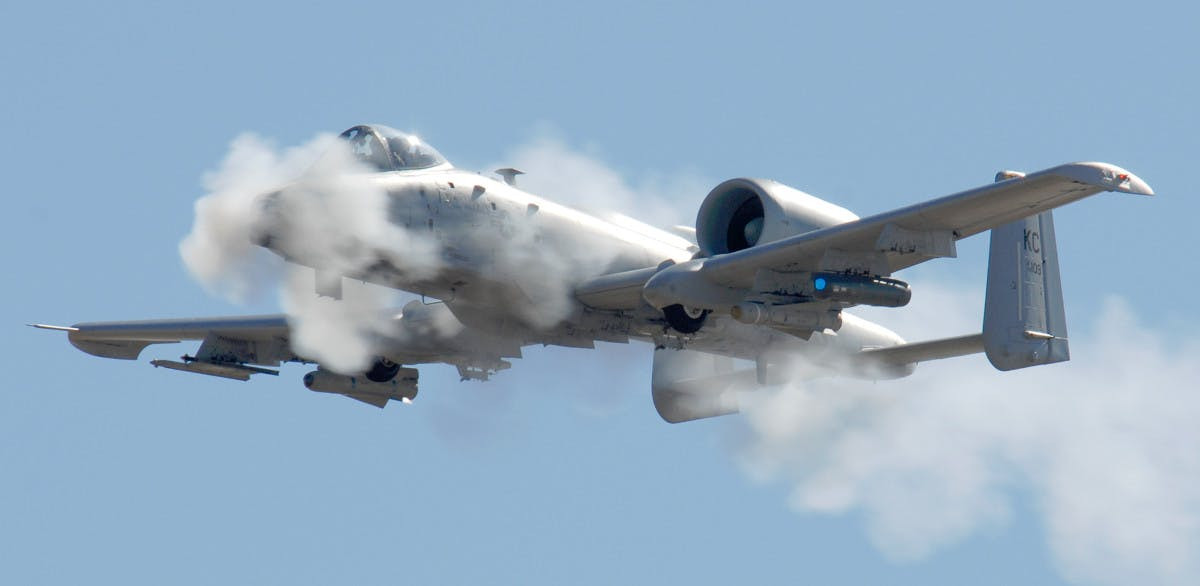
Scrapping the older versions of the PGU-14/B does offer the Air Force the opportunity to ditch the controversial ammunition for good. DU is a byproduct of the process of making uranium fuel for nuclear reactors and is both denser and cheaper than alternatives, such as tungsten. The U.S. military had used it for decades to make armor-piercing projectiles, as well as super-strong armor plating.
The problem is that it’s also mildly radioactive, though it only emits alpha particles that your clothing and even skin can block, and studies have also indicated that its a toxic carcinogen. As such, there have long been concerns that depleted uranium projectiles, which shatter and burn on impact, have been contaminating the soil and water in areas where the U.S. military has used them extensively, such as Iraq during the first Gulf War and the 2003 U.S.-led invasion. DU has been one of the many factors possibly responsible for various illnesses that have emerged in large numbers among Gulf War Veterans, which have become known as Gulf War Syndrome.
The U.S. government’s position continues to be that there is no conclusive evidence linking the rounds to the health issues, which is true. At the same time, it has been extremely difficult for researchers to go to places, such as Iraq, to conduct long-term field studies that could provide enough data to put the debate to rest for good. It has been difficult to even get a full accounting of where and when the U.S. military has used DU ammunition. From what is known, the PGU-14/B ammunition has only seen limited use in more recent conflicts in places such as Iraq and Syria, where there has been a dearth of targets that require is armor-piercing properties.
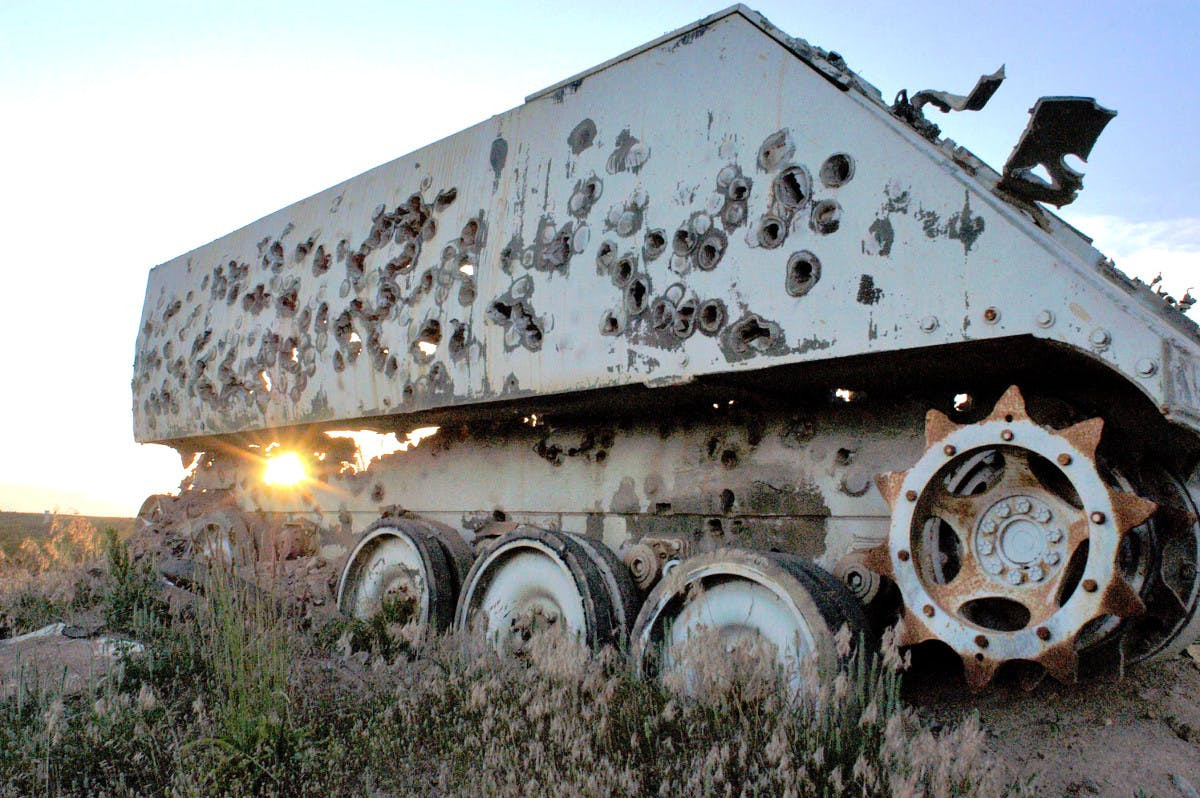
The War Zone has reached out to the Air Force to try to confirm whether or not this contracting announcement means that they have decided to stop using 30mm DU ammunition in the A-10 completely. We will be sure to update this story with any additional information we receive.
If the service has retired the rounds, it would certainly be good for public relations and there is already at least one 30x173mm tungsten-cored round available, which is in use in the Goalkeeper naval close-in weapon system. This system also features a GAU-8/A cannon.

Still, getting rid of the PGU-14/Bs could result in some loss of capability given that the other available options, such as tungsten, simply do not perform as well. While not necessarily an issue with regards to lower-end conflicts, such as those in Afghanistan, Iraq, and Syria, this could be worrisome with regards to potential major conflicts against larger opponents with more traditional standing armies.
The U.S. military, as a whole, has seen a general shift toward preparing again for particularly high-end wars against “great power competitors,” such as Russia and China, operating large numbers of tanks and other heavy armored vehicles. Smaller forces, including non-state actors, have also demonstrated their ability to acquire and employ armored vehicles, including as suicide bombs, to varying degrees, on multiple occasions in recent years.
Of course, the GAU-8/As and the A-10s that carry them are only one, relatively small piece of the puzzle when it comes to defeating enemy tanks and armored vehicles on the battlefield. The Air Force, as well as the U.S. military as a whole, may see the mix of anti-armor capabilities it has, or is otherwise developing, as sufficient to mitigate any impact from removing the PGU-14/B ammunition from service.
A 30mm armor-piercing shell using tungsten could still be very effective against a wide array of targets, too, though its cost might limit its availability compared to existing DU shells, to some degree. At the same time, the A-10’s ability to launch precision-guided attacks, using everything from laser-guided 70mm rockets to GPS-guided Joint Direct Attack Munition (JDAM) bombs, means it does not have to rely as heavily on its gun, either.
Whether or not the Air Force has decided to stop flying A-10s with loads of DU ammunition on the A-10s, or why, the stockpile of more than 35,000,000 existing rounds in Army custody appears to have outlived its usefulness.
Contact the author: joe@thedrive.com
